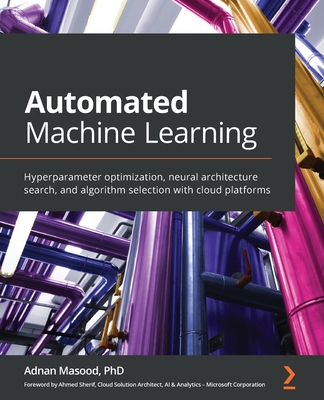Designing Deep Learning Systems: A Software Engineer's Guide
暫譯: 設計深度學習系統:軟體工程師指南
Wang, Chi, Szeto, Donald
- 出版商: Manning
- 出版日期: 2023-07-25
- 定價: $2,150
- 售價: 9.0 折 $1,935
- 語言: 英文
- 頁數: 360
- 裝訂: Quality Paper - also called trade paper
- ISBN: 1633439860
- ISBN-13: 9781633439863
-
相關分類:
DeepLearning
-
相關翻譯:
設計深度學習系統 (簡中版)
立即出貨 (庫存 < 4)
買這商品的人也買了...
-
 Linkers and Loaders (Paperback)
Linkers and Loaders (Paperback)$2,460$2,337 -
 UNIX Systems for Modern Architectures: Symmetric Multiprocessing and Caching for Kernel Programmers
UNIX Systems for Modern Architectures: Symmetric Multiprocessing and Caching for Kernel Programmers$2,560$2,432 -
 人月神話:軟體專案管理之道 (20 週年紀念版)(The Mythical Man-Month: Essays on Software Engineering, Anniversary Edition, 2/e)
人月神話:軟體專案管理之道 (20 週年紀念版)(The Mythical Man-Month: Essays on Software Engineering, Anniversary Edition, 2/e)$480$379 -
 程式設計師的自我修養-連結、載入、程式庫
程式設計師的自我修養-連結、載入、程式庫$580$458 -
 Debug Hacks 除錯駭客 -- 極致除錯的技巧與工具
Debug Hacks 除錯駭客 -- 極致除錯的技巧與工具$580$458 -
 Binary Hacks -- 駭客秘傳技巧一百招
Binary Hacks -- 駭客秘傳技巧一百招$580$458 -
 Linux Kernel Hacks 改善效能、提昇開發效率及節能的技巧與工具
Linux Kernel Hacks 改善效能、提昇開發效率及節能的技巧與工具$680$537 -
 Serverless Security: Understand, Assess, and Implement Secure and Reliable Applications in Aws, Microsoft Azure, and Google Cloud
Serverless Security: Understand, Assess, and Implement Secure and Reliable Applications in Aws, Microsoft Azure, and Google Cloud$2,370$2,252 -
 軟體架構原理|工程方法 (Fundamentals of Software Architecture: A Comprehensive Guide to Patterns, Characteristics, and Best Practices)
軟體架構原理|工程方法 (Fundamentals of Software Architecture: A Comprehensive Guide to Patterns, Characteristics, and Best Practices)$680$537 -
 $1,944Practical Deep Learning: A Python-Based Introduction
$1,944Practical Deep Learning: A Python-Based Introduction -
 Parallel and High Performance Computing (Paperback)
Parallel and High Performance Computing (Paperback)$2,450$2,328 -
 Developing Graphics Frameworks with Python and OpenGL (Hardcove)
Developing Graphics Frameworks with Python and OpenGL (Hardcove)$4,200$3,990 -
 $2,682Practical Machine Learning for Computer Vision: End-To-End Machine Learning for Images (Paperback)
$2,682Practical Machine Learning for Computer Vision: End-To-End Machine Learning for Images (Paperback) -
 $2,233Optimizing Visual Studio Code for Python Development: Developing More Efficient and Effective Programs in Python
$2,233Optimizing Visual Studio Code for Python Development: Developing More Efficient and Effective Programs in Python -
 Deep Learning with Python, 2/e (Paperback)
Deep Learning with Python, 2/e (Paperback)$2,300$2,185 -
 電腦視覺機器學習實務|建立端到端的影像機器學習 (Practical Machine Learning for Computer Vision: End-To-End Machine Learning for Images)
電腦視覺機器學習實務|建立端到端的影像機器學習 (Practical Machine Learning for Computer Vision: End-To-End Machine Learning for Images)$780$616 -
 $1,755Learn Three.js : Program 3D animations and visualizations for the web with JavaScript and WebGL, 4/e (Paperback)
$1,755Learn Three.js : Program 3D animations and visualizations for the web with JavaScript and WebGL, 4/e (Paperback) -
 Hands-On Computer Vision with Detectron2: Develop object detection and segmentation models with a code and visualization approach
Hands-On Computer Vision with Detectron2: Develop object detection and segmentation models with a code and visualization approach$1,690$1,606 -
 $505Python 分佈式機器學習
$505Python 分佈式機器學習 -
 從 AI 到 生成式 AI:40個零程式的實作體驗,培養新世代人工智慧素養
從 AI 到 生成式 AI:40個零程式的實作體驗,培養新世代人工智慧素養$560$442 -
 $2,641Machine Learning with Python Cookbook: Practical Solutions from Preprocessing to Deep Learning 2nd Edition
$2,641Machine Learning with Python Cookbook: Practical Solutions from Preprocessing to Deep Learning 2nd Edition -
 ChatGPT-4 與 Bing Chat - 創新體驗文字/繪圖/音樂/動畫/影片的AI世界
ChatGPT-4 與 Bing Chat - 創新體驗文字/繪圖/音樂/動畫/影片的AI世界$520$411 -
 萬顆 GPU 的訓練 - 分散式機器學習 — 系統工程與實戰
萬顆 GPU 的訓練 - 分散式機器學習 — 系統工程與實戰$1,280$1,011 -
 K8S 自學聖經:10大核心模板快速入門【圖解教學】
K8S 自學聖經:10大核心模板快速入門【圖解教學】$790$624 -
 威脅建模|開發團隊的實務指南 (Threat Modeling: A Practical Guide for Development Teams)
威脅建模|開發團隊的實務指南 (Threat Modeling: A Practical Guide for Development Teams)$680$537
商品描述
A vital guide to building the platforms and systems that bring deep learning models to production.
Summary
In Designing Deep Learning Systems you will learn how to:
- Transfer your software development skills to deep learning systems
- Recognize and solve common engineering challenges for deep learning systems
- Understand the deep learning development cycle
- Automate training for models in TensorFlow and PyTorch
- Optimize dataset management, training, model serving and hyperparameter tuning
- Pick the right open-source project for your platform
Deep learning systems are the components and infrastructure essential to supporting a deep learning model in a production environment. Written especially for software engineers with minimal knowledge of deep learning's design requirements, Designing Deep Learning Systems is full of hands-on examples that will help you transfer your software development skills to creating these deep learning platforms. You'll learn how to build automated and scalable services for core tasks like dataset management, model training/serving, and hyperparameter tuning. This book is the perfect way to step into an exciting--and lucrative--career as a deep learning engineer.
Purchase of the print book includes a free eBook in PDF, Kindle, and ePub formats from Manning Publications.
About the technology
To be practically usable, a deep learning model must be built into a software platform. As a software engineer, you need a deep understanding of deep learning to create such a system. Th is book gives you that depth.
About the book
Designing Deep Learning Systems: A software engineer's guide teaches you everything you need to design and implement a production-ready deep learning platform. First, it presents the big picture of a deep learning system from the developer's perspective, including its major components and how they are connected. Then, it carefully guides you through the engineering methods you'll need to build your own maintainable, efficient, and scalable deep learning platforms.
What's inside
- The deep learning development cycle
- Automate training in TensorFlow and PyTorch
- Dataset management, model serving, and hyperparameter tuning
- A hands-on deep learning lab
About the reader
For software developers and engineering-minded data scientists. Examples in Java and Python.
About the author
Chi Wang is a principal software developer in the Salesforce Einstein group. Donald Szeto was the co-founder and CTO of PredictionIO.
Table of Contents
1 An introduction to deep learning systems
2 Dataset management service
3 Model training service
4 Distributed training
5 Hyperparameter optimization service
6 Model serving design
7 Model serving in practice
8 Metadata and artifact store
9 Workflow orchestration
10 Path to production
商品描述(中文翻譯)
建立將深度學習模型投入生產的平台和系統的重要指南。
摘要
在設計深度學習系統中,您將學習如何:
- 將您的軟體開發技能轉移到深度學習系統
- 識別並解決深度學習系統的常見工程挑戰
- 理解深度學習開發週期
- 自動化TensorFlow和PyTorch中的模型訓練
- 優化數據集管理、訓練、模型服務和超參數調整
- 為您的平台選擇合適的開源專案
深度學習系統是支持深度學習模型在生產環境中運行的組件和基礎設施。本書設計深度學習系統專為對深度學習設計要求知識有限的軟體工程師而寫,充滿了實用的範例,幫助您將軟體開發技能轉移到創建這些深度學習平台上。您將學會如何為數據集管理、模型訓練/服務和超參數調整等核心任務構建自動化和可擴展的服務。本書是進入一個令人興奮且有利可圖的深度學習工程師職業的完美途徑。
購買印刷版書籍可獲得Manning Publications提供的免費PDF、Kindle和ePub格式電子書。
關於技術
為了實際可用,深度學習模型必須構建在軟體平台上。作為一名軟體工程師,您需要對深度學習有深入的理解,以創建這樣的系統。本書將為您提供這種深度知識。
關於本書
設計深度學習系統:軟體工程師指南教您設計和實現生產就緒的深度學習平台所需的一切。首先,它從開發者的角度呈現深度學習系統的全貌,包括其主要組件及其連接方式。然後,它仔細指導您通過構建可維護、高效和可擴展的深度學習平台所需的工程方法。
內容概覽
- 深度學習開發週期
- 在TensorFlow和PyTorch中自動化訓練
- 數據集管理、模型服務和超參數調整
- 實作深度學習實驗室
關於讀者
適合軟體開發人員和具工程思維的數據科學家。範例使用Java和Python。
關於作者
Chi Wang是Salesforce Einstein團隊的首席軟體開發人員。Donald Szeto是PredictionIO的共同創辦人和CTO。
目錄
1 深度學習系統簡介
2 數據集管理服務
3 模型訓練服務
4 分散式訓練
5 超參數優化服務
6 模型服務設計
7 實踐中的模型服務
8 元數據和工件存儲
9 工作流程編排
10 生產之路
作者簡介
Chi Wang is a principal software developer in the Salesforce Einstein group where he builds the deep learning platform for millions of Salesforce customers. Previously, he worked at Microsoft Bing and Azure on building large-scale distributed systems. Chi has filed six patents, mostly in deep learning systems.
Donald Szeto was the co-founder and CTO of PredictionIO, a startup that aimed to help democratize and accelerate the adoption of machine learning. PredictionIO was acquired by Salesforce, where he continued his work on machine learning and deep learning systems. Donald is currently investing in, advising, and mentoring technology startups.
作者簡介(中文翻譯)
Chi Wang 是 Salesforce Einstein 團隊的首席軟體開發人員,他為數百萬 Salesforce 客戶構建深度學習平台。之前,他曾在 Microsoft Bing 和 Azure 工作,專注於構建大規模分散式系統。Chi 已申請六項專利,主要涉及深度學習系統。
Donald Szeto 是 PredictionIO 的共同創辦人及首席技術官,該初創公司旨在幫助民主化和加速機器學習的採用。PredictionIO 被 Salesforce 收購後,他繼續在機器學習和深度學習系統方面工作。Donald 目前正在投資、諮詢和指導科技初創公司。






























